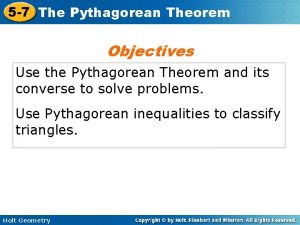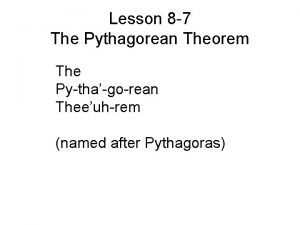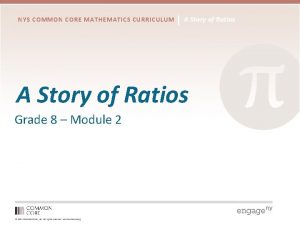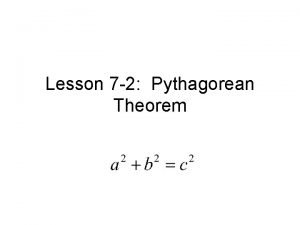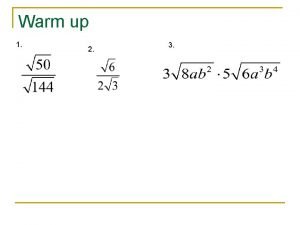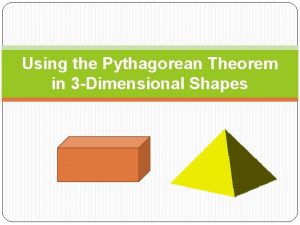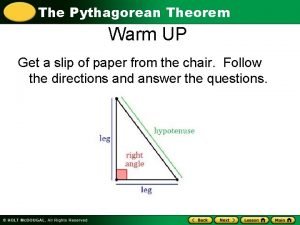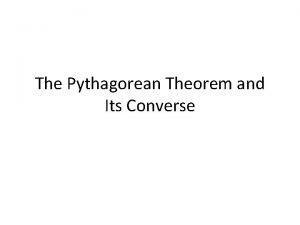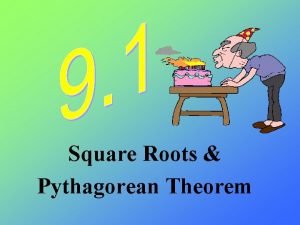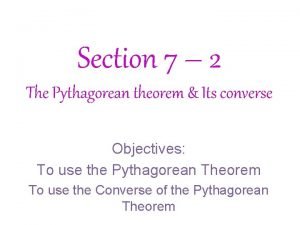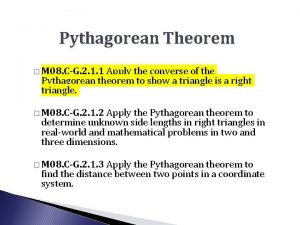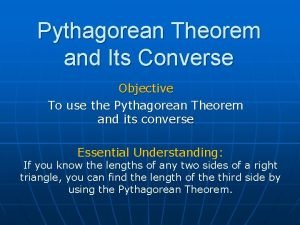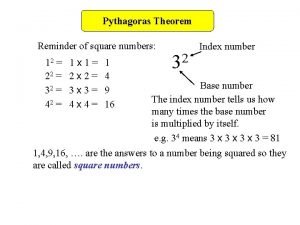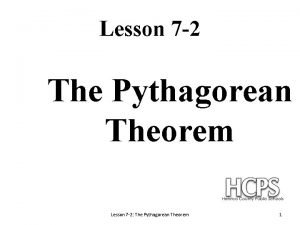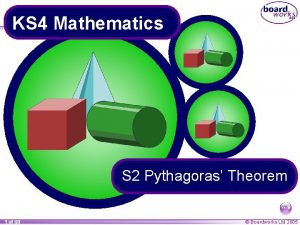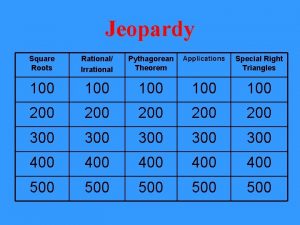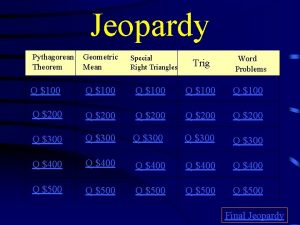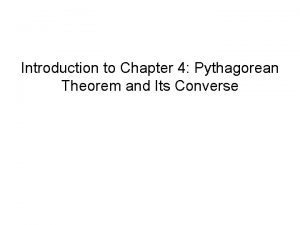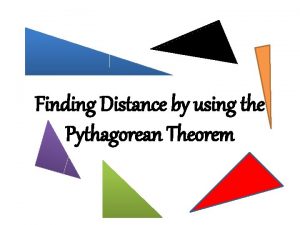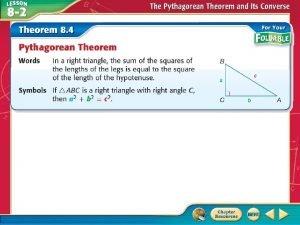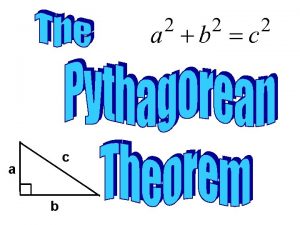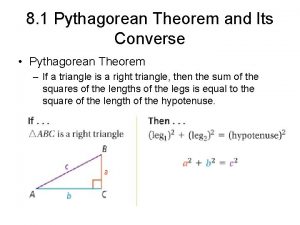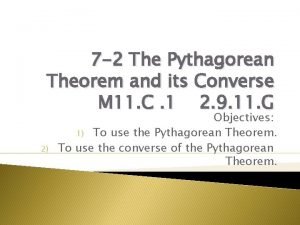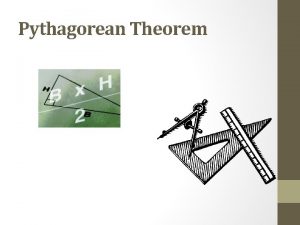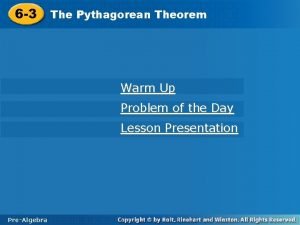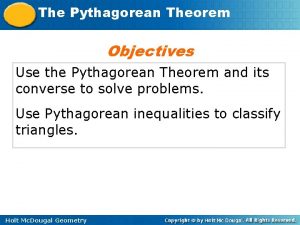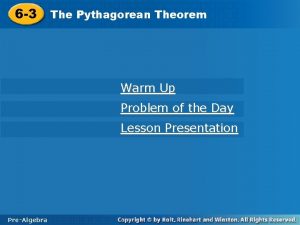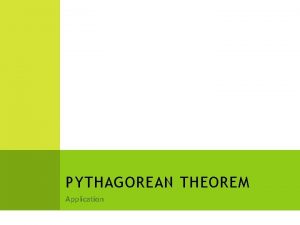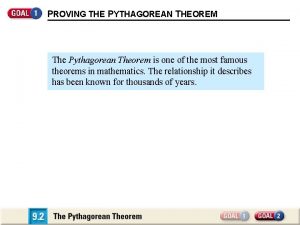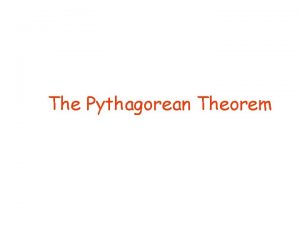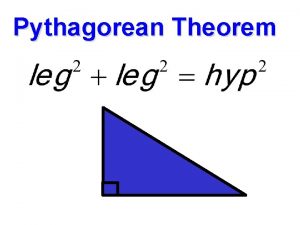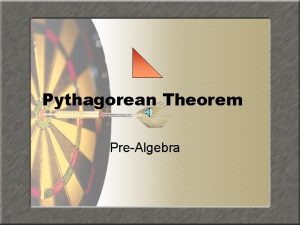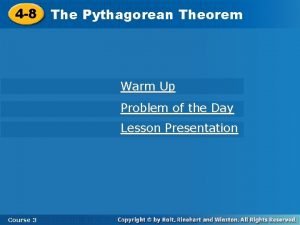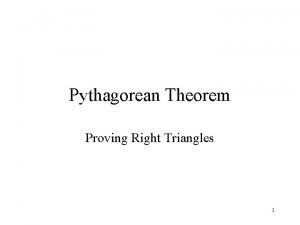Lesson 7 2 The Pythagorean Theorem Lesson 7







































- Slides: 39

Lesson 7 -2 The Pythagorean Theorem Lesson 7 -2: The Pythagorean Theorem 1

Anatomy of a right triangle • The hypotenuse of a right triangle is the longest side. It is opposite the right angle. • The other two sides are legs. They form the right angle. leg hypotenuse leg Lesson 7 -2: The Pythagorean Theorem 2

The Pythagorean Theorem 1. Draw a right triangle with lengths a, b and c. (c the hypotenuse) 2. Draw a square on each side of the triangle. 3. What is the area of each square? a 2 a b 2 b c c 2 Lesson 7 -2: The Pythagorean Theorem

The Pythagorean Theorem a 2 a The Pythagorean Theorem says a 2 + b 2 = c 2 b c c 2 Lesson 7 -2: The Pythagorean Theorem

Proofs of the Pythagorean Theorem Proof 1 Proof 2 Proof 3 Lesson 7 -2: The Pythagorean Theorem 5

The Pythagorean Theorem If a triangle is a right triangle, with leg lengths a and b and hypotenuse c, then a 2 + b 2 = c 2 c a c is the length of the hypotenuse! b Lesson 7 -2: The Pythagorean Theorem 6

The Pythagorean Theorem If a triangle is a right triangle, then leg 2 + leg 2 = hyp 2 hyp leg Lesson 7 -2: The Pythagorean Theorem 7

Example In the following figure if a = 3 and b = 4, Find c. leg 2 + leg 2 = hyp 2 32 + 42 = C 2 9 + 16 = C 2 c a 25 = C 2 5 = C b Lesson 7 -2: The Pythagorean Theorem 8

Pythagorean Theorem : Examples 1. a = 8, b = 15, Find c c = 17 2. a = 7, b = 24, Find c c = 25 3. a = 9, b = 40, Find c c = 41 4. a = 10, b = 24, Find c c = 26 5. c = 10 a = 6, b = 8, Find c a Lesson 7 -2: The Pythagorean Theorem c b 9

Finding the legs of a right triangle: In the following figure if b = 5 and c = 13, Find a. leg 2 + leg 2 = hyp 2 a 2 +52 = 132 c a b a 2 + 25 = 169 -25 a 2 = 144 a = 12 Lesson 7 -2: The Pythagorean Theorem 10

More Examples: 1) 2) 3) 4) 5) 6) 7) 8) a=8, c =10 , Find b a=15, c=17 , Find b b =10, c=26 , Find a a=15, b=20, Find c a =12, c=16, Find b b =5, c=10, Find a a =6, b =8, Find c a=11, c=21, Find b b=6 b=8 a = 24 c = 25 a = 8. 7 c = 10 c a b Lesson 7 -2: The Pythagorean Theorem 11

A Little More Triangle Anatomy • The altitude of a triangle is a segment from a vertex of the triangle perpendicular to the opposite side. altitude Lesson 7 -2: The Pythagorean Theorem 12

Altitude - Special Segment of Triangle Definition: a segment from a vertex of a triangle perpendicular to the segment that contains the opposite side. In a right triangle, two of the altitudes are the legs of the triangle. B F I A A D D In an obtuse triangle, two of the altitudes are outside of the triangle. K Lesson 3 -1: Triangle Fundamentals 13

Example: • An altitude is drawn to the side of an equilateral triangle with side lengths 10 inches. What is the length of the altitude? h 2 + 52 = 102 h 2 = 75 10 in h= ? 5 in 10 in Lesson 7 -2: The Pythagorean Theorem 14

The Pythagorean Theorem – in Review Pythagorean Theorem: If a triangle is a right triangle, with side lengths a, b and c (c the hypotenuse, ) c a then a 2 + b 2 = c 2 What is the converse? b Lesson 7 -2: The Pythagorean Theorem 15

The Converse of the Pythagorean Theorem If, a 2 + b 2 = c 2, then the triangle is a right triangle. c a C is the LONGEST side! b Lesson 7 -2: The Pythagorean Theorem 16

Given the lengths of three sides, how do you know if you have a right triangle? Given a = 6, b=8, and c=10, describe the triangle. Compare a 2 + b 2 and c 2: c a b a 2 + b 2 62 + 82 36 + 64 100 = = c 2 100 100 Since 100 = 100, this is a right triangle. Lesson 7 -2: The Pythagorean Theorem 17

The Contrapositive of the Pythagorean Theorem If a 2 + b 2 c 2 then the triangle is NOT a right triangle. c a What if a 2 + b 2 c 2 ? b Lesson 7 -2: The Pythagorean Theorem 18

The Contrapositive of the Pythagorean Theorem If a 2 + b 2 c 2 then either, a 2 + b 2 > c 2 or a 2 + b 2 < c 2 c a What if a 2 + b 2 c 2 ? b Lesson 7 -2: The Pythagorean Theorem 19

The Converse of the Pythagorean Theorem If a 2 + b 2 > c 2 , then the triangle is acute. c a The longest side is too short! b Lesson 7 -2: The Pythagorean Theorem 20

The Converse of the Pythagorean Theorem If a 2 + b 2 < c 2 , then the triangle is obtuse. a b The longest side is too long! c Lesson 7 -2: The Pythagorean Theorem 21

Given the lengths of three sides, how do you know if you have a right triangle? Given a = 4, b = 5, and c =6, describe the triangle. Compare a 2 + b 2 and c 2: a c b a 2 + b 2 42 + 52 16 + 25 41 > > c 2 62 36 36 Since 41 > 36, this is an acute triangle. Lesson 7 -2: The Pythagorean Theorem 22

Given the lengths of three sides, how do you know if you have a right triangle? Given a = 4, b = 6, and c = 8, describe the triangle. Compare a 2 + b 2 and c 2: b a c a 2 + b 2 42 + 62 16 + 36 52 < < c 2 82 64 64 Since 52 < 64, this is an obtuse triangle. Lesson 7 -2: The Pythagorean Theorem 23

Describe the following triangles as acute, right, or obtuse right 1) 9, 40, 41 obtuse 2) 15, 20, 10 obtuse 3) 2, 5, 6 4) 12, 16, 20 right 5) 14, 12, 11 acute 6) 2, 4, 3 obtuse 7) 1, 7, 7 acute 8) 90, 150, 120 c a right Lesson 7 -2: The Pythagorean Theorem b 24

Application The Distance Formula

The Pythagorean Theorem • For a right triangle with legs of length a and b and hypotenuse of length c, or

The x-axis • Start with a horizontal number line which we will call the xaxis. • We know how to measure the distance between two points on a number line. x Take the absolute value of the difference: │a – b │ │ – 4 – 9 │= │ – 13 │ = 13

The y-axis • Add a vertical number line which we will call the y-axis. • Note that we can measure the distance between two points on this number line also. y x

The Coordinate Plane We call the x-axis together with the y-axis the coordinate plane. y x

Coordinates / Ordered Pair • Coordinates – numbers that identify the position of a point • Ordered Pair – a pair of numbers (xcoordinate, y-coordinate) identifying a point’s position Identify some coordinates and ordered pairs in the diagram. Diagram is from the website www. ezgeometry. com.

Finding Distance in The Coordinate Plane We can find the distance between any two points in the coordinate plane by using the Ruler Postulate AND the Pythagorean Theorem. y ? x

Finding Distance in The Coordinate Plane cont. First, draw a right triangle. y ? x

Finding Distance in The Coordinate Plane cont. Next, find the lengths of the two legs. • First, the horizontal leg: │(– 4) – 8│= │– 12│ = 12 y – 4 12 ? 8 x

Finding Distance in The Coordinate Plane cont. So the horizontal leg is 12 units long. • Now find the length of the vertical leg: │3 – (– 2)│= │ 5 │ = 5 y 3 5 – 2 ? x 12

Finding Distance in The Coordinate Plane cont. Here is what we know so far. Since this is a right triangle, we use the Pythagorean Theorem. y The distance is 13 units. ? 13 12 5 x

The Distance Formula Instead of drawing a right triangle and using the Pythagorean Theorem, we can use the following formula: distance = where (x 1, y 1) and (x 2, y 2) are the ordered pairs corresponding to the two points. So let’s go back to the example.

Example Find the distance between these two points. Solution: First : Find the coordinates of each point. y (8, 3) – 4 3 ? x – 2 (– 4, – 2) 8

Example Find the distance between these two points. Solution: First: Find the coordinates of each point. (x 1, y 1) = (-4, -2) y (x 2, y 2) = (8, 3) ? x (– 4, – 2)

Example cont. Solution cont. Then: Since the ordered pairs are (x 1, y 1) = (-4, -2) and (x 2, y 2) = (8, 3) Plug in x 1 = -4, y 1 = -2, x 2 = 8 and y 2 = 3 into distance = = 13
 Lesson 6 use the pythagorean theorem answer key page 427
Lesson 6 use the pythagorean theorem answer key page 427 Lesson 5-7 practice b the pythagorean theorem
Lesson 5-7 practice b the pythagorean theorem 5-7 practice b the pythagorean theorem
5-7 practice b the pythagorean theorem Lesson-8
Lesson-8 Lesson 9 sequencing rotations
Lesson 9 sequencing rotations Lesson 7-2 the pythagorean theorem and its converse answers
Lesson 7-2 the pythagorean theorem and its converse answers Difference between green and stokes theorem
Difference between green and stokes theorem Pythagorean theorem warm up
Pythagorean theorem warm up Pythagorean theorem 3 dimensions
Pythagorean theorem 3 dimensions Pythagorean inequality theorem
Pythagorean inequality theorem Pythagorean theorem warm up
Pythagorean theorem warm up Essential question for pythagorean theorem
Essential question for pythagorean theorem The pythagorean theorem and its converse
The pythagorean theorem and its converse Practice 11-2 the pythagorean theorem answer key
Practice 11-2 the pythagorean theorem answer key Square root pythagorean theorem
Square root pythagorean theorem Pythagorean theorem
Pythagorean theorem 7-2 the pythagorean theorem and its converse
7-2 the pythagorean theorem and its converse Baseball pythagorean theorem
Baseball pythagorean theorem Converse of the pythagorean theorem worksheet
Converse of the pythagorean theorem worksheet Pythagorean theorem
Pythagorean theorem Number
Number Pythagoras number
Pythagoras number Google maps pythagorean theorem
Google maps pythagorean theorem Lesson 7: distance on the coordinate plane
Lesson 7: distance on the coordinate plane Pythagorean theorem equilateral triangle formula
Pythagorean theorem equilateral triangle formula Jeopardy rational and irrational numbers
Jeopardy rational and irrational numbers Pythagorean theorem jeopardy
Pythagorean theorem jeopardy Pythagorean theorem and its converse worksheet
Pythagorean theorem and its converse worksheet Finding distance using pythagorean theorem
Finding distance using pythagorean theorem Use the pythagorean theorem to find the missing measure.
Use the pythagorean theorem to find the missing measure. Right triangle families
Right triangle families Pythagorean theorem odyssey
Pythagorean theorem odyssey Pythagorean theorem volume
Pythagorean theorem volume Pythagorean theorem essential questions
Pythagorean theorem essential questions Applying the pythagorean theorem homework 3
Applying the pythagorean theorem homework 3 Facts about the pythagorean theorem
Facts about the pythagorean theorem Practice 8-1 the pythagorean theorem and its converse
Practice 8-1 the pythagorean theorem and its converse The pythagorean theorem and its converse 8-1
The pythagorean theorem and its converse 8-1 8-2 the pythagorean theorem and its converse
8-2 the pythagorean theorem and its converse 7-2 the pythagorean theorem and its converse
7-2 the pythagorean theorem and its converse


